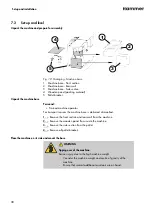
32
Transporting, packing, storing
6 Transporting, packing, storing
6.1
Transport inspection
1.
Upon arrival, inspect the shipment to ensure that it is complete and has not
suffered any damage.
2.
If any transport damage is visible from the outside, do not accept the
delivery or only accept it with reservation.
3.
Record the scope of the damage on the transport documents/hauliers
delivery note.
4.
Initiate the complaint process.
5.
Any defects that are not discovered upon delivery, must be reported as soon
as they are identified as damage claims are only valid if claimed within the
valid complaint period.
6.2
Packaging
If no agreement has been made with the supplier to take back the packaging
materials, help to protect the environment by reusing the materials or separating
them according to type and size for recycling.
Environmental protection
Packaging materials are valuable raw materials and in many cases they can be
used again, reprocessed or recycled.
ENVIRONMENT
Dispose of the packaging in an environmentally friendly manner
−
Dispose of packaging materials in an environmentally friendly
manner and in accordance with the applicable local disposal
regulations.
−
Contract a recycling company.
6.3
Storage
Keep items sealed in their packaging until they are assembled/installed and be
sure to observe the stacking and storage symbols on the outside of the packaging.
Storage conditions
●
Do not store outdoors.
●
Store in a dry and dust-free environment. Use desiccant if necessary.
●
Protect from direct sunlight.
●
Avoid mechanical vibration.
●
Storage temperature: -10 °C to +50 °C.
●
Humidity: max. 90 % non-wetting
●
Avoid extreme temperature fluctuations (condensation build-up).
●
Apply a coat of oil to all exposed machine parts (corrosion protection).
●
Regularly check the general condition of all parts and the packaging during
longer storage (> 3 months). If necessary, refresh or re-apply the coat of
anti-corrosive agent.
















































